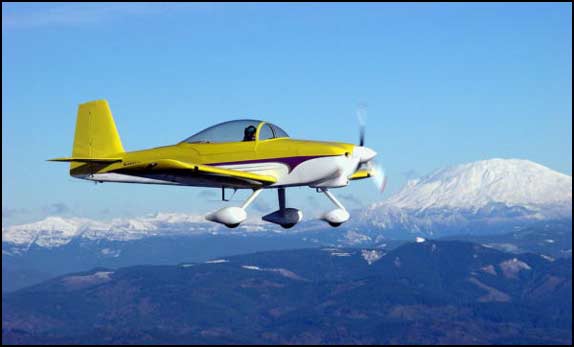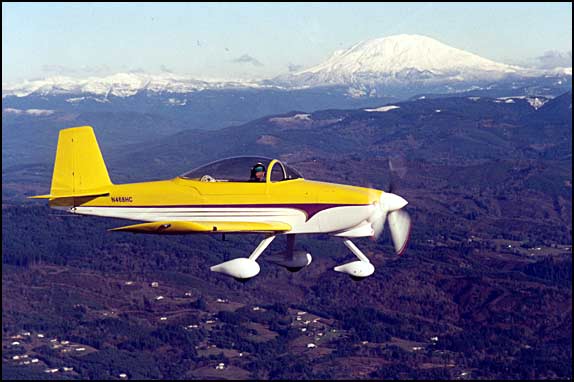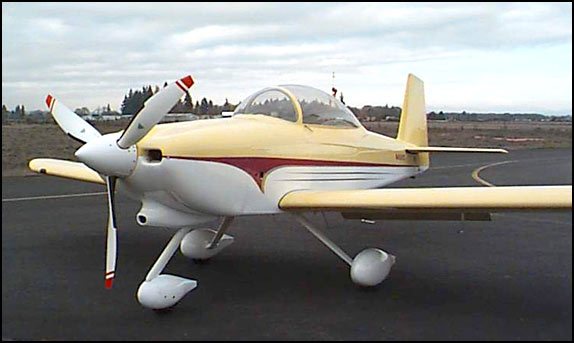|
The
Building Of An RV-8A
Hopes,
Wishes, And Outcomes By: Harmon C. Lange We all need a good reason to build another airplane right? Well I was convinced that flying in the RV-4 was not good for my back. Several long cross country trips in the 4 had me laid up, hurting, Enough said on that. It was time to start building the RV-8A. The question has been asked of me, why did I install all the fancy stuff? I will try to explain. I think it was the trip back from Oshkosh 1999 that started the thought process. For all the years that I have been flying, I considered myself a very cautious pilot in regards to weather. Some might say cowardly. On that ’99 OSH trip, I pushed it a bit too far and had to make a 180° turn in bad conditions. Fortunately the RV-6A has the wing leveler and I basically made the turn with that. During most of the turn I had no visibility at all, but came out of it without a problem. However, I still remember how totally disoriented and stupid I felt. Had I made the turn a mere 20 seconds earlier, it would have left me with an entirely different feeling. For many weeks after that trip I was haunted. The first thought that came to mind waking in the morning and the last thought at night was the possibility of cashing in my chips for a mere 20 seconds. Think about that. Life can get pretty short. Another factor that still haunts me is the accident and death of a dear pilot friend and his son, who also got caught in bad weather. So it came to pass that the next plane would have a new type of instrument panel. To many of the best pilots who are sharp and keep IFR current, the standard type instruments that have been available for many years are the best. But, there is nothing inherently obvious in them. In my opinion it is better to have the equipment draw you a picture. Anyone can fly a picture. Isn’t that what we do when VFR? We all remember the famous 200 hrs pilot that died in good weather, but no visibility. I’m sure the Saratoga had the best standard IFR equipment available, yet he died. It happens. Like every one else, I have been watching the revolution in cockpit displays. About 6 years ago I sat in on one of Burt Rutan's forums. It was about this very subject. The objective is to have a display that allows you to fly the airplane with the same references, VFR, or IFR, (having the horizon, the image of the ground, and the surrounding terrain.) I didn’t know it then, but sitting in that same audience was a young genius that took up the challenge. Several years later I got to meet him, Greg Richter, CEO of Blue Mountain Avionics. They produce the EFIS 1. Think glass cockpit. I attended his forum at OSH, and heard and saw all his neat ideas. He promised 3-D terrain modeling, highway in the sky, and more. I related that as a machinist I have been programming CNC equipment. It does just what I want it to do, time after time after time. “Why can’t we program airplanes to cut a path through the sky, the same as a tool cuts a path though steel?” Greg said, “We could do that”. So, hopefully we are on the way. The EFIS 1 is available with integrated autopilot. When I first started flying it we had some power supply problems. Greg quickly solved that with new power supplies. I’ve had full confidence in Greg from the start, and he has given great support. The 3-D terrain images on the screen are just great. Take a peak at his web site; you’ll see what I mean. What about the FADEC system? (Full Authority Digital Engine Control). About the time I was getting serious about spending money for an engine, I happened to meet Van at one of our many “Fly out for Breakfast Mornings.” He suggested I look into having an engine built up without the mags, and carburetor, and put the FADEC on. I called Ed Bartow, the man with the most time on an RV and FADEC combination. He was having good results, and encouraged me to go for it. The cost was about the same as a new engine. I paid $13,000.00 for the basic engine from Aero Sport. (It’s a 0360 A1A.) The FADEC system was $7,000.00. So, 20k and some change for a fuel injected engine. I liked the idea that the only moving part in the entire system is the small solenoid on each cylinder that is activated to inject the fuel. Ed has 400 hrs on his system without any problems. With that information I ordered the system. The big surprise came when it was time to order the prop. The Hartzel people, after doing some testing, advised against using their prop on the FADEC run engine. They were in the process of a new design so I postponed the purchase as long as I could. In the end I bought an MT constant speed 3-blade prop. The MT props are made of wood, and are not subject to the problems of harmonic vibration that the metal props have. At this time I have logged over 200 hrs. The FADEC has not missed a beat. It seems to be a bit cold blooded and coughs some when I start the engine in temps around 30 degrees. During flight the system re-computes for high and low cruse. This means that when one changes the power through the 65 percent range you can expect a slight roughness until it changes over. I’m comfortable with that now, and can refer to the readout on the Ipaq display to see what is happening. The message comes up as low or high power cruse, stabilizing, calibrating, and complete. Then it is running perfectly smooth again. The Ipaq displays all the info from the FADEC computers, including the percentage of power. That is really neat. The Blue Mountain display just keeps getting better. Since I started flying the 8A, Greg has updated the hardware to eliminate in-flight use of the DVD drive. All the maps are now on a 1-gig flash card. The DVD is only used for the monthly updates. I did not intend to discuss the airplane itself in this letter. The RV-8A that I have is a standard quick build kit.
|
| Langair Machining, Inc. Email: harmon@langair.com
|


